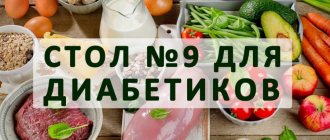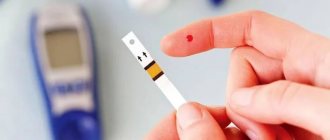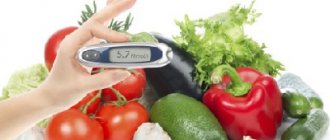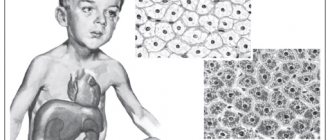General rules
What is diabetes mellitus and what diet is indicated for this disease? Diabetes mellitus is a disease that occurs when the pancreas does not produce enough insulin. It often develops with a hereditary predisposition, and one of the factors contributing to its development is overeating, excess consumption of fats and simple carbohydrates. The disease is based on carbohydrate metabolism disorders: poor absorption of glucose by tissues, increased formation of it from fats, proteins and glycogen .
As a result, there is an increase in blood sugar and its determination in the urine. Diabetics are also characterized by disorders of fat metabolism and accumulation of fat oxidation products in the blood - ketone bodies .
Diabetes mellitus is complicated by atherosclerosis , fatty liver , and kidney damage. Nutrition is a therapeutic factor in mild forms of the disease, the main point in moderate diabetes, and necessary for the treatment of severe forms while taking insulin and oral hypoglycemic drugs.
Patients are prescribed Diet No. 9, Table No. 9 according to Pevzner or its variations. This medical diet provides for the normalization of carbohydrate metabolism, and a balanced diet prevents disorders of fat metabolism. Dietary Table No. 9 is distinguished by a moderately reduced energy value due to a significant reduction in carbohydrates (easily digestible, simple) and fats. Sugar and confectionery products are excluded, salt and cholesterol . The amount of proteins is within the physiological norm. Therapeutic nutrition is prescribed by a doctor depending on the degree of hyperglycemia , the patient’s weight and concomitant diseases.
With normal weight, the daily calorie intake is 2300-2500 kcal, 90-100 g of protein, 75-80 g of fat and 300-350 g of carbohydrates, which, at the discretion of the doctor, is distributed between intake with bread or cereals and vegetables.
Nutrition is of particular importance when combined with obesity . Weight loss has a beneficial effect on the course of diabetes - reduced sensitivity to insulin . If you are overweight, calorie content is reduced to 1700 kcal due to a significant restriction of carbohydrates to 120 g per day. In this case, the patient receives 110 g of protein and 80 g of fat. The patient is also shown fasting diets and days.
Diet table No. 9 for mild diabetes mellitus
- sugar;
- preserves, jams;
- confectionery;
- ice cream;
- syrups;
- sweet fruits and vegetables;
- pasta;
- White bread.
It is recommended to limit or exclude:
- potatoes, as a highly starchy product;
- carrots (for the same reasons);
- tomatoes due to their high glucose content;
- beets (has a high glycemic index, after its consumption there is a jump in blood sugar levels).
Since nutrition for diabetes is based on limiting carbohydrates, it is advisable to choose even fruits with a glycemic index (GI) of up to 55: grapefruits, lingonberries, apricots, cherry plums, apples, cranberries, peaches, plums, cherries, sea buckthorn, red currants, gooseberries. But even these fruits should be consumed in limited quantities (serving up to 200 g).
When consuming foods with a high GI, blood sugar levels rise greatly, which causes increased insulin . It should also be taken into account that heat treatment of vegetables increases the GI, so stewed zucchini, eggplant, and cabbage can adversely affect sugar levels.
It must be remembered that sugar and its products are excluded in mild cases of the disease, and against the background of insulin therapy for moderate and severe diabetes mellitus, 20-30 g of sugar are allowed. Thus, the treatment table is modified by the doctor depending on the severity of the disease, the intensity of the patient’s work, weight, age and insulin therapy. This is done by regulating carbohydrate content.
In all cases, be sure to include in the diet:
- eggplant;
- red salad pepper due to its high vitamin ;
- pumpkin (helps reduce glucose);
- zucchini and squash, which normalize carbohydrate metabolism;
- lipotropic products (cottage cheese, oatmeal, soy).
Since carbohydrates must be present in the diet and provide 55% of the daily energy value, it is necessary to include sources of slowly absorbed carbohydrates with dietary fiber: wholemeal bread, legumes, whole grain cereals, vegetables, fruits.
It is advisable to adhere to the following distribution of the energy value of the diet:
- 20% should be for breakfast;
- 10% - for second breakfast;
- 30% - for lunch;
- 10% - afternoon snack;
- 20% - dinner;
- 10% on overnight meals.
The diet includes xylitol , fructose , or sorbitol at the expense of total carbohydrates. For taste, it is allowed to add saccharin .
Xylitol is equivalent in sweetness to regular sugar and its daily dose is no more than 30 g.
Fructose has low calorie content and low GI, and is twice as sweet as sugar, so adding 1 tsp is enough. in tea. With this dietary diet, the amount of salt is limited (12 g per day), and according to indications (for nephropathy and hypertension ) it is further reduced (2.8 g per day).
Nutrition for type 2 diabetes and excess body weight
The use of any medications for type 2 diabetes mellitus still cannot fully compensate for the effect of poor nutrition on blood glucose levels. Proper nutrition is a critical component of effective treatment for type 2 diabetes and will help you achieve your blood glucose goals. Dietary approaches for people with type 2 diabetes, who may or may not be overweight, have hypertension, etc., will vary somewhat. The vast majority of people with excess body weight due to type 2 diabetes mellitus. Excess weight prevents your own insulin from working effectively, causing your blood glucose levels to remain high. Therefore, weight loss is an indispensable condition for rational treatment! Even moderate weight loss (5-10%) improves carbohydrate metabolism, especially in the early period of the disease. How to achieve weight loss? It should be immediately noted that there are no specific products or medicinal plants for weight loss. There are currently no medications that, on their own, without following a diet, could provide highly effective and completely safe weight loss.
The only reliable way is to limit the intake of energy into the body (it is indicated in calories), i.e. compliance with the rules of low-calorie nutrition . The resulting energy deficit leads to the fact that energy reserves “conserved” in adipose tissue will be spent on various needs of the body, and weight will certainly decrease.
The carriers of energy in food are its three components: proteins, fats and carbohydrates . The most high-calorie of them are fats, they contain 9 kcal in 1 gram; in proteins and carbohydrates - 4 kcal per gram. The most effective way to reduce caloric intake is to reduce the fat content in it. This is not only safe, but also useful for modern people, since our diet, unfortunately, is oversaturated with fats. Compared to fats, the calorie content of proteins and carbohydrates can be considered moderate, however, in order to achieve a good effect in weight loss, they still need to be slightly limited. There are a number of foods that do not need to be limited when losing weight. On the contrary, it is these products that can compensate for the above restrictions and replenish the reduced amount of food. This group of foods consists mainly of vegetables, which are poor in nutrients but rich in water, as well as plant fibers , which are not digestible. Plant fibers bring many benefits to the body: improve intestinal function, help the absorption of vitamins, have a beneficial effect on fat metabolism, etc. There are three groups of foods that need to be consumed differently in order to lose weight. Looking at these groups, you will definitely have an association with a traffic light.
- Limit as much as possible
High calorie foods: fatty foods, alcohol, sugar and confectionery
Examples: any butter, lard, sour cream, mayonnaise; cream, fatty cottage cheese and cheese; oily fish, poultry skin, canned meat; fish and vegetables in oil; fatty meat, smoked meats, sausages; sugar, sweet drinks, honey, preserves, jams, candies, cakes, cookies, chocolate, ice cream, nuts, seeds, alcoholic drinks.
- Limit moderately (eat half your usual serving)
Medium-calorie foods: protein, starchy, dairy products, fruits and berries.
Examples: milk and fermented milk products of regular fat content or low-fat/low-fat, cheeses less than 30% fat, cottage cheese less than 4% fat, eggs, lean meats, fish, pasta, bread and non-fat bakery products, cereals; fruits, potatoes, corn, ripe peas and beans.
- Use without restrictions
Products with minimal calorie content: vegetables (except for potatoes, corn, mature peas and beans), as well as low-calorie drinks.
Examples: radishes, radishes, beets, carrots, mushrooms, cucumbers, tomatoes, peppers, zucchini, eggplants, beans, young green peas, lettuce, greens, spinach, sorrel, any cabbage; tea, coffee without sugar and cream, mineral water.
Is it possible to maintain a low-calorie diet without counting calories? This is quite possible if you follow the principles of product selection outlined above. Moreover, experts have long recognized that what is important is not the number of calories that a person needs to consume (it is quite difficult to accurately indicate it for each person), but the amount by which a person has actually reduced his diet! An indicator of correct adherence to the principles of low-calorie nutrition will be the achievement of results: weight loss! If the weight does not decrease, this indicates that it has not yet been possible to significantly reduce the calorie content of the diet. How do different carbohydrates affect blood glucose levels?
Carbohydrates are the only nutrients that directly increase blood glucose, but this is not a reason to sharply limit them.
There should be enough carbohydrates in the diet of any person, including a person with diabetes (at least 50% of the total calories), since they are a source of energy for the body. Moreover, different carbohydrates have different effects on blood glucose levels. There are simple carbohydrates (they are called sugars), which are absorbed very easily because they consist of small molecules and are quickly absorbed in the digestive tract (within 10 minutes). They immediately and greatly increase blood glucose levels. It is these carbohydrates that make up sugar, honey, a lot of them are found in fruit juices (natural fruit also contains them, but due to the presence of fiber, the absorption of carbohydrates does not occur so quickly), and beer. Such carbohydrates are also found in liquid dairy products, but due to the fat content, carbohydrates are not absorbed so quickly. Another type of carbohydrates is complex (starches), they also increase blood glucose levels, but not as quickly and not as strongly as simple carbohydrates. Representatives of the following products: bread, cereals, pasta, potatoes, corn. The starch molecule is large, and the body has to work hard to absorb it. Therefore, the glucose formed as a result of the breakdown of starch is absorbed more slowly (after about 30 minutes), which increases its level in the blood to a lesser extent. Culinary processing of starchy foods (any grinding, prolonged heat exposure) helps to raise blood glucose levels. This means that a strong increase in blood glucose when consuming starches can be prevented by using certain food processing and preparation methods. For example, it is better to cook potatoes not in the form of mashed potatoes, but to boil them whole in their skins, so that they remain dense. It is also better not to cook porridge for too long. It is preferable to prepare them from large uncrushed grains (buckwheat, rice). Enriching food with plant fibers prevents increases in blood glucose levels. Therefore, it is better to buy grain or bran bread, and not from fine flour. Consume fruits and berries in their natural form, and not in the form of juices.
There are types of carbohydrate products - “free” , after which the level of glucose in the blood does not increase or increases only slightly. Such products include almost all types of vegetables in normal quantities (except potatoes). For example, cabbage, lettuce, parsley, dill, radishes, turnips, zucchini, eggplant, pumpkin, peppers, etc. Among the products of this group, the largest amount of carbohydrates is contained in beets and carrots, but the rise in blood glucose after them is not very large. Therefore, if you eat them in moderate quantities (as a side dish, no more than 200 g), they can also be ignored.
Do I need to count carbs? A person with type 2 diabetes mellitus, receiving tablets of glucose-lowering drugs or only following a diet, does not need to accurately count the amount of carbohydrates in food. Many people with diabetes have heard of so-called bread units. A system of such calculation exists for those who receive insulin. It correlates the amount of carbohydrates consumed with the doses of short-acting insulin that these people with diabetes take before meals. Special “diabetic” products Sweeteners allow you to give food a sweet taste without increasing blood glucose levels and without gaining weight. But in this case we are talking only about non-calorie sugar substitutes. These include aspartame, saccharin, cyclamate, acesulfame potassium, sucralose, stevioside. They do not affect blood glucose levels or weight at all. However, most “diabetic” products (cookies, chocolate, waffles) contain sorbitol, xylitol or fructose instead of sugar, which are almost as high in calories as sugar. Therefore, if you are overweight, they should be limited as much as possible, just like regular sweets. Fractional diet A fractional diet means eating multiple meals during the day (5-6 times, but still no more than every 2.5-3 hours) in small portions. This is helpful because eating a low-calorie diet can make you feel hungry. Eating more frequently will help reduce it. In addition, a small portion of food contains some carbohydrates, and this will facilitate the work of the pancreas. Alcohol Due to its high calorie content (7 kcal per 1 g), alcohol can contribute to weight gain. In addition, it directly worsens fat metabolism and blood pressure. Therefore, limit your alcohol intake as much as possible. Alcohol is known to have adverse effects on the liver. It can cause hypoglycemia if a person with diabetes is taking antihyperglycemic drugs and insulin. Under no circumstances should you drink alcoholic beverages on an empty stomach!
Varieties
Basic Table No. 9 is prescribed for a short period of time to determine tolerance to carbohydrates and to select doses of oral medications in cases where diet fails to normalize sugar levels. During the trial diet, fasting sugar is checked once every 3-5 days. When test results are normalized, after 2-3 weeks the diet is gradually expanded, adding 1 XE (bread unit) every week.
One unit of bread corresponds to 12-15 g of carbohydrates and is contained in 25-30 g of bread, 0.5 cup of buckwheat porridge, 1 apple, 2 pcs. prunes Having expanded it by 12 XE, it is prescribed for 2 months, after which another 4 XE are added. Further expansion of the diet is carried out after 1 year. The table is also indicated for ongoing use in mild to moderate type 2 diabetes
Diet 9A is recommended for mild to moderate forms of non-insulin-dependent diabetes, but patients obesity
Table No. 9B is indicated for patients with severe insulin-dependent diabetes, and it differs from the previous ones in its increased carbohydrate content (400-450 g) due to the consumption of bread, potatoes, cereals, vegetables and fruits. The amount of proteins and fats has been slightly increased. We can say that the diet is close in composition to a rational table. Its energy value is 2700-3100 kcal. Instead of sugar, use sweeteners and 20-30 g of sugar.
If the patient administers insulin in the morning and afternoon, then 65-70% of carbohydrates should come from these meals. After administering insulin, food should be taken twice - after 15-20 minutes and after 2.5-3 hours, when the maximum effect of insulin is noted. This is ensured by fractional meals with the intake of carbohydrate foods (porridge, potatoes, fruits, fruit juices, bread) for the 2nd breakfast and afternoon snack.
Authorized Products
The consumption of rye bread, wheat bread (from second grade flour), with bran up to 300 g per day is provided.
First courses can be made with weak meat or vegetable broth. Preference should be given to vegetable soups (borscht, cabbage soup), okroshka, mushroom soup; soups with meatballs and cereals are also allowed. Potatoes in soups may be present in limited quantities.
Proper nutrition for diabetes
Dietary food includes all vegetables that are used raw or stewed (as side dishes). The emphasis is on low-carbohydrate vegetables (pumpkin, zucchini, eggplant, cucumbers, lettuce, cabbage, squash). Potatoes are allowed with restrictions taking into account the carbohydrate norm for each patient individually (most often no more than 200 g in all dishes). Carrots and beets are high in carbohydrates. With the doctor's permission, these vegetables are also included in the diet.
Lean meats and chicken are allowed. It is better to cook meat dishes boiled or baked to reduce the calorie content of food. When it comes to fish, you should choose dietary types: pike perch, cod, hake, pollock, pike, navaga. The amount of cereal is limited to the norm for each patient (usually 8-10 tablespoons per day) - buckwheat, barley, pearl barley, millet and oatmeal; legumes are allowed (lentils are preferable). If you have eaten pasta (in limited quantities and occasionally), then on this day you need to reduce the amount of bread.
Fermented milk drinks (low-fat kefir, yogurt) should be included in the diet daily. Milk and low-fat cottage cheese are consumed in their natural form and dishes are prepared from them: milk porridges, casseroles, soufflés. Mild cheese with a fat content of no more than 30% is allowed in small quantities; sour cream is added only to dishes. Butter and various vegetable oils should be added to prepared dishes. Eggs - one per day, soft-boiled or in the form of an omelet. Drinks allowed: coffee with milk, tea with sweetener, vegetable juices, rosehip decoction.
Sweet and sour berries are allowed in any form (fresh, compotes, jellies, mousses, xylitol jam). If you use xylitol , then no more than 30 g per day, fructose is allowed 1 tsp. three times a day (add to drinks). Honey 1 tsp. 2 times a day. You can eat confectionery products (sweets, waffles, cookies) with sugar substitutes. But even in this case, there is a norm - 1-2 candies twice a week.
Table of permitted products
| Proteins, g | Fats, g | Carbohydrates, g | Calories, kcal | |
Vegetables and greens | ||||
| zucchini | 0,6 | 0,3 | 4,6 | 24 |
| cabbage | 1,8 | 0,1 | 4,7 | 27 |
| sauerkraut | 1,8 | 0,1 | 4,4 | 19 |
| cauliflower | 2,5 | 0,3 | 5,4 | 30 |
| cucumbers | 0,8 | 0,1 | 2,8 | 15 |
| radish | 1,2 | 0,1 | 3,4 | 19 |
| tomatoes | 0,6 | 0,2 | 4,2 | 20 |
| pumpkin | 1,3 | 0,3 | 7,7 | 28 |
Fruits | ||||
| apricots | 0,9 | 0,1 | 10,8 | 41 |
| watermelon | 0,6 | 0,1 | 5,8 | 25 |
| cherry | 0,8 | 0,5 | 11,3 | 52 |
| pears | 0,4 | 0,3 | 10,9 | 42 |
| nectarine | 0,9 | 0,2 | 11,8 | 48 |
| peaches | 0,9 | 0,1 | 11,3 | 46 |
| plums | 0,8 | 0,3 | 9,6 | 42 |
| apples | 0,4 | 0,4 | 9,8 | 47 |
Berries | ||||
| cowberry | 0,7 | 0,5 | 9,6 | 43 |
| blackberry | 2,0 | 0,0 | 6,4 | 31 |
| raspberries | 0,8 | 0,5 | 8,3 | 46 |
| currant | 1,0 | 0,4 | 7,5 | 43 |
Cereals and porridges | ||||
| buckwheat (kernel) | 12,6 | 3,3 | 62,1 | 313 |
| oat groats | 12,3 | 6,1 | 59,5 | 342 |
| corn grits | 8,3 | 1,2 | 75,0 | 337 |
| pearl barley | 9,3 | 1,1 | 73,7 | 320 |
| millet cereal | 11,5 | 3,3 | 69,3 | 348 |
| barley grits | 10,4 | 1,3 | 66,3 | 324 |
Bakery products | ||||
| Rye bread | 6,6 | 1,2 | 34,2 | 165 |
| bran bread | 7,5 | 1,3 | 45,2 | 227 |
| doctor's bread | 8,2 | 2,6 | 46,3 | 242 |
| whole grain bread | 10,1 | 2,3 | 57,1 | 295 |
Confectionery | ||||
| diabetic crackers | 10,5 | 5,7 | 73,1 | 388 |
Raw materials and seasonings | ||||
| xylitol | 0,0 | 0,0 | 97,9 | 367 |
| honey | 0,8 | 0,0 | 81,5 | 329 |
| fructose | 0,0 | 0,0 | 99,8 | 399 |
Dairy | ||||
| milk | 3,2 | 3,6 | 4,8 | 64 |
| kefir | 3,4 | 2,0 | 4,7 | 51 |
| sour cream 15% (low fat) | 2,6 | 15,0 | 3,0 | 158 |
| curdled milk | 2,9 | 2,5 | 4,1 | 53 |
| acidophilus | 2,8 | 3,2 | 3,8 | 57 |
| yogurt | 4,3 | 2,0 | 6,2 | 60 |
Cheeses and cottage cheese | ||||
| cottage cheese 0.6% (low fat) | 18,0 | 0,6 | 1,8 | 88 |
| cottage cheese 1.8% (low-fat) | 18,0 | 1,8 | 3,3 | 101 |
| cottage cheese 5% | 17,2 | 5,0 | 1,8 | 121 |
Meat products | ||||
| beef | 18,9 | 19,4 | 0,0 | 187 |
| beef tongue | 13,6 | 12,1 | 0,0 | 163 |
| veal | 19,7 | 1,2 | 0,0 | 90 |
| rabbit | 21,0 | 8,0 | 0,0 | 156 |
Bird | ||||
| chicken | 16,0 | 14,0 | 0,0 | 190 |
| turkey | 19,2 | 0,7 | 0,0 | 84 |
Eggs | ||||
| chicken eggs | 12,7 | 10,9 | 0,7 | 157 |
Fish and seafood | ||||
| herring | 16,3 | 10,7 | — | 161 |
Oils and fats | ||||
| butter | 0,5 | 82,5 | 0,8 | 748 |
| corn oil | 0,0 | 99,9 | 0,0 | 899 |
| olive oil | 0,0 | 99,8 | 0,0 | 898 |
| sunflower oil | 0,0 | 99,9 | 0,0 | 899 |
| ghee | 0,2 | 99,0 | 0,0 | 892 |
Non-alcoholic drinks | ||||
| mineral water | 0,0 | 0,0 | 0,0 | — |
| coffee | 0,2 | 0,0 | 0,3 | 2 |
| instant chicory | 0,1 | 0,0 | 2,8 | 11 |
| black tea without sugar | 0,1 | 0,0 | 0,0 | — |
Juices and compotes | ||||
| carrot juice | 1,1 | 0,1 | 6,4 | 28 |
| plum juice | 0,8 | 0,0 | 9,6 | 39 |
| tomato juice | 1,1 | 0,2 | 3,8 | 21 |
| pumpkin juice | 0,0 | 0,0 | 9,0 | 38 |
| rose hip juice | 0,1 | 0,0 | 17,6 | 70 |
| Apple juice | 0,4 | 0,4 | 9,8 | 42 |
| * data is per 100 g of product | ||||
Fully or partially limited products
Excluded from the diet: baked goods, sweet desserts and ice cream, curd mass and sweet curd cheeses, rice, semolina and pasta. Milk soups with these products are also not allowed.
You should not consume sweet juices, preserves and jams (the exception is these preparations with xylitol), and lemonades with sugar.
It is better to avoid fried foods, eating spicy and too salty foods, and hot sauces.
It is advisable not to consume canned food (fish and meat).
Fatty broths and fatty meats, smoked meats, sausages, fatty sauces and cream are prohibited.
Liver, egg yolks, and honey are allowed in limited quantities.
Table of prohibited products
| Proteins, g | Fats, g | Carbohydrates, g | Calories, kcal | |
Vegetables and greens | ||||
| carrot | 1,3 | 0,1 | 6,9 | 32 |
| beet | 1,5 | 0,1 | 8,8 | 40 |
| horseradish | 3,2 | 0,4 | 10,5 | 56 |
Fruits | ||||
| pineapples | 0,4 | 0,2 | 10,6 | 49 |
| bananas | 1,5 | 0,2 | 21,8 | 95 |
| melon | 0,6 | 0,3 | 7,4 | 33 |
| mango | 0,5 | 0,3 | 11,5 | 67 |
Berries | ||||
| grape | 0,6 | 0,2 | 16,8 | 65 |
Nuts and dried fruits | ||||
| raisin | 2,9 | 0,6 | 66,0 | 264 |
| dried figs | 3,1 | 0,8 | 57,9 | 257 |
| dates | 2,5 | 0,5 | 69,2 | 274 |
Cereals and porridges | ||||
| semolina | 10,3 | 1,0 | 73,3 | 328 |
| rice | 6,7 | 0,7 | 78,9 | 344 |
| sago | 1,0 | 0,7 | 85,0 | 350 |
Flour and pasta | ||||
| pasta | 10,4 | 1,1 | 69,7 | 337 |
| noodles | 12,0 | 3,7 | 60,1 | 322 |
Bakery products | ||||
| wheat bread | 8,1 | 1,0 | 48,8 | 242 |
Confectionery | ||||
| jam | 0,3 | 0,2 | 63,0 | 263 |
| candies | 4,3 | 19,8 | 67,5 | 453 |
| pastry cream | 0,2 | 26,0 | 16,5 | 300 |
Ice cream | ||||
| ice cream | 3,7 | 6,9 | 22,1 | 189 |
Chocolate | ||||
| chocolate | 5,4 | 35,3 | 56,5 | 544 |
Raw materials and seasonings | ||||
| mustard | 5,7 | 6,4 | 22,0 | 162 |
| mayonnaise | 2,4 | 67,0 | 3,9 | 627 |
| sugar | 0,0 | 0,0 | 99,7 | 398 |
Dairy | ||||
| baked milk | 3,0 | 6,0 | 4,7 | 84 |
| cream | 2,8 | 20,0 | 3,7 | 205 |
| sour cream 25% (classic) | 2,6 | 25,0 | 2,5 | 248 |
| sour cream 30% | 2,4 | 30,0 | 3,1 | 294 |
| Ryazhenka 6% | 5,0 | 6,0 | 4,1 | 84 |
| ayran (tan) | 1,1 | 1,5 | 1,4 | 24 |
| fruit yogurt 3.2% | 5,0 | 3,2 | 8,5 | 85 |
Cheeses and cottage cheese | ||||
| glazed cheese | 8,5 | 27,8 | 32,0 | 407 |
| curd | 7,1 | 23,0 | 27,5 | 341 |
Meat products | ||||
| pork | 16,0 | 21,6 | 0,0 | 259 |
| salo | 2,4 | 89,0 | 0,0 | 797 |
Bird | ||||
| smoked chicken | 27,5 | 8,2 | 0,0 | 184 |
| duck | 16,5 | 61,2 | 0,0 | 346 |
| smoked duck | 19,0 | 28,4 | 0,0 | 337 |
| goose | 16,1 | 33,3 | 0,0 | 364 |
Fish and seafood | ||||
| smoked fish | 26,8 | 9,9 | 0,0 | 196 |
| canned fish | 17,5 | 2,0 | 0,0 | 88 |
| sardine in oil | 24,1 | 13,9 | — | 221 |
| cod (liver in oil) | 4,2 | 65,7 | 1,2 | 613 |
Oils and fats | ||||
| animal fat | 0,0 | 99,7 | 0,0 | 897 |
| cooking fat | 0,0 | 99,7 | 0,0 | 897 |
Non-alcoholic drinks | ||||
| lemonade | 0,0 | 0,0 | 6,4 | 26 |
| Pepsi | 0,0 | 0,0 | 8,7 | 38 |
Juices and compotes | ||||
| grape juice | 0,3 | 0,0 | 14,0 | 54 |
| * data is per 100 g of product | ||||
Therapeutic Diet Menu No. 9 (Diet)
Diet menu No. 9 for diabetes should include 5-6 meals a day, in which the amount of carbohydrates should be evenly distributed. For each patient, the amount of carbohydrates and foods is specified by the doctor and their daily count is important.
An approximate set of products for each day might look like this:
- butter 20 g, vegetable oil 30 g;
- meat and fish 100-130 g each;
- cottage cheese 200 g;
- milk and fermented milk products - up to 400 ml;
- sour cream 20 g;
- oatmeal (buckwheat) 50 g;
- vegetables up to 800 g (tomatoes 20 g, carrots 75 g, zucchini 250 g, cabbage 250 g, potatoes 200 g);
- fruits 300 g (mainly apples 200 g, grapefruits 100 g);
- rye bread from 100 to 200 g.
The menu for every day of the 9th table diet needs to be adjusted for yourself, taking into account the amount of carbohydrates allowed by your doctor and the daily calorie content of food. Below is a sample menu for a week according to generally accepted recommendations for therapeutic nutrition.
When creating a weekly menu for yourself, try to diversify it, use the permitted amount of sweeteners that can be added to drinks and dishes (casseroles, jellies) and use fruit snacks more often, then the diet will be easily tolerated.
Monday
| Breakfast |
|
| Lunch |
|
| Dinner |
|
| Afternoon snack |
|
| Dinner |
|
| For the night |
|
Tuesday
| Breakfast |
|
| Lunch |
|
| Dinner |
|
| Afternoon snack |
|
| Dinner |
|
| For the night |
|
Wednesday
| Breakfast |
|
| Lunch |
|
| Dinner |
|
| Afternoon snack |
|
| Dinner |
|
| For the night |
|
Thursday
| Breakfast |
|
| Lunch |
|
| Dinner |
|
| Afternoon snack |
|
| Dinner |
|
| For the night |
|
Friday
| Breakfast |
|
| Lunch |
|
| Dinner |
|
| Afternoon snack |
|
| Dinner |
|
| For the night |
|
Saturday
| Breakfast |
|
| Lunch |
|
| Dinner |
|
| Afternoon snack |
|
| Dinner |
|
| For the night |
|
Sunday
| Breakfast |
|
| Lunch |
|
| Dinner |
|
| Afternoon snack |
|
| Dinner |
|
| For the night |
|
What sweeteners can be used
Since a diet for diabetes involves the exclusion of sugar, it can be replaced with sweeteners of natural or synthetic origin on the recommendation of a doctor.
Natural sugar substitutes
Diet number 9 allows for the introduction of natural sweeteners into the diet. There are several varieties of these products:
- sorbitol;
- fructose;
- stevia;
- xylitol
All sweeteners except stevia are high in calories. They should be introduced into the diet with caution, and strict calorie tracking is recommended. If patients are overweight, it is recommended to use only stevia, since the product is considered the safest.
Stevia is one of the safest sugar substitutes for people with diabetes.
Synthetic sweeteners
Artificial sweeteners include syrups or tablets:
- Acesulfame potassium;
- Sodium cyclamate;
- Aspartame.
Each of the drugs has its own contraindications. Acesulfame potassium is prohibited among patients with heart failure. People suffering from kidney pathologies should not add sodium cyclamate to their diet. Aspartame is excluded if there is a violation of amino acid metabolism in the body. To prevent serious consequences, it is recommended to take artificial sweeteners strictly as prescribed by your doctor.
Recipes
First meal
Summer diet soup
Broth, vegetable oil, onions, carrots, cabbage (cauliflower and broccoli), potatoes, green beans, greens.
Dip the potatoes into the broth, after 10 minutes add cabbage and chopped green beans. Sauté onions and chopped carrots in a frying pan with butter. Add the sauté to the vegetables and cook until tender. When serving, sprinkle with herbs.
Vegetable soup with meatballs
Vegetable broth, butter, beef, carrots, onions, cabbage (cauliflower broccoli), chicken protein, greens.
Make minced beef, add onions, dill, chicken protein, salt and pepper. Form meatballs. Put carrots, cabbage, and onions sautéed in vegetable oil into the broth, and when the broth boils, drop the meatballs into it. Cook until the meatballs are ready, serve with herbs.
Second courses
Steamed veal cutlets
Veal, milk, onion, butter.
Pass the meat and onion through a meat grinder. Pour in milk and melted butter, add salt. You can add grated carrots to give it a nice color. Place the cutlets on a steamer grid. Cook for 15-20 minutes. Serve with stewed vegetables.
Fish baked with sour cream
Pike perch, sour cream, vegetable oil, salt, parsley.
Cut the fish into portions and place on a baking sheet. Add salt, place onion rings on it, sprinkle with vegetable oil and grease with sour cream. Bake for 25-30 minutes. Serve with lettuce or any vegetables.
Potato zrazy
Beef, potatoes, salt, onions, vegetable oil, herbs.
Pass the boiled meat and sautéed onions through a meat grinder. Grate the boiled potatoes and add salt. Form circles from the potato mixture and place minced meat in the middle, form into balls, sprinkle with cheese. Cook in a steam bath, you can bake.
Dessert
Cottage cheese casserole with pumpkin
Pumpkin, cream, cottage cheese, eggs, vanillin to taste, xylitol.
Cut the pumpkin into cubes. Mix cottage cheese, cream, eggs and xylitol using a blender. Add pumpkin to the curd mixture. Place the mixture in a greased baking dish and bake for about 30 minutes at 180°C.
Diet recipes No. 9
Table 9 recipes include healthy foods prepared from low-calorie foods by boiling, stewing or baking.
Baked vegetables with asparagus
To prepare the dish you will need the following products:
- asparagus;
- onion;
- cauliflower;
- zucchini;
- tomatoes;
- carrot;
- greenery.
Peel the vegetables, rinse, cut into small cubes. Cut off the lower coarse stems from the asparagus and chop it. Steam vegetables and asparagus until half cooked. After this, place the product in the oven, adding a little olive oil and salt. Bake the dish until cooked at 180 degrees. The second option for preparing the dish is stewing in a frying pan.
Curd soufflé with apples
The dish includes:
- cottage cheese;
- apples;
- chicken eggs.
Curd soufflé with apples is a healthy dietary dish, approved for illness
To prepare the dish you will need 500 g of cottage cheese. The product must be kneaded well and passed through a sieve until a homogeneous consistency is obtained. Add 2 eggs and grated apples to the resulting mass and mix thoroughly. The mass is laid out in molds and baked for 15 - 20 minutes at a temperature of 180 degrees.
Peppers stuffed with vegetables
To prepare the dish you will need:
- bell pepper;
- tomatoes;
- bulb onions;
- zucchini;
- hard cheese;
- rice;
- salt.
Chop tomatoes, onions, zucchini. Boil the rice until half cooked, mix with vegetables. Add grated cheese and salt to taste. Stuff the peppers with the resulting mixture and place them on a baking sheet greased with olive oil. Bake the dish in the oven at 200 degrees until cooked.
Zucchini with minced chicken
To prepare the dish you will need the following products:
- fresh zucchini;
- bulb onions;
- minced chicken;
- hard cheese;
- low-fat cream;
- greenery;
- salt.
Place minced meat on a baking sheet greased with vegetable oil, put on top a layer of onions, cut into half rings, then a layer of cream, coarsely grated zucchini, cheese, and cream again. The dish is baked at 180 degrees for 30–40 minutes. Before serving, the casserole is decorated with herbs.
Diabetes mellitus is a serious disease that requires an integrated approach to treatment. Maintaining proper nutrition is an important aspect in the treatment of the disease. The correct choice of products and recipes for their preparation will help normalize the patient’s condition and prevent undesirable consequences of pathology.
Diet 9 during pregnancy and lactation
Diabetes mellitus can have a latent form and first manifests itself during pregnancy . This is true diabetes mellitus . Gestational diabetes may occur , which appears during pregnancy due to a decrease in tissue sensitivity to insulin. After delivery, there is a possibility of normalization of carbohydrate metabolism. However, there is a risk of developing diabetes in the future.
High glucose levels pose a danger to mother and child: risk of miscarriage , pyelonephritis , fundus vascular complications and complications during childbirth. Therefore, it is so important for pregnant women to regularly monitor sugar levels and follow nutritional recommendations if they increase.
- The diet completely excludes “simple” carbohydrates, which cause a sharp increase in blood sugar, and limits the amount of complex carbohydrates. Eliminate sweets, sugary carbonated drinks, white bread, grapes, bananas, sweet juices and dried fruits. Eat foods that contain fiber, which slows down the flow of glucose into the blood. Its sources are vegetables and unsweetened fruits.
- Pasta and potatoes should be present in small quantities.
- It is recommended to eat every two hours. There should be three main meals and two additional ones. After dinner, you can drink half a glass of kefir or eat half an apple.
- Throughout the day, constantly measure your glucose level after meals (to do this, you need to purchase a glucometer).
- Eliminate fatty foods and fried foods, fast food products. It is recommended to avoid sausage and smoked meats.
- Do not limit fluid intake.
- Steaming or stewing using vegetable oil is preferred.
Compliance with these recommendations is necessary even after pregnancy , for at least two months, followed by a blood sugar examination and consultation with an endocrinologist.
Diabetes and diet: everything is mixed with sugar
One of the main myths circulating on the Internet: a diabetic cannot eat food with carbohydrates! In fact, if you refuse such food, you can very quickly go “to the next world.” As well as eating too much of it. To understand what the catch is, you need to understand the concept of “diabetes”.
In a nutshell, the disease can be characterized as follows: diabetics have a metabolic disorder due to problems with the production of the hormone insulin, which is responsible for the absorption of sugar. Sugar (glucose) serves as food for all cells of the body - it provides energy. There is no insulin - sugar does not enter the cells, but accumulates, poisoning the body. In other words, there is no life without sugar, and the problem with diabetes is that it ends up in the wrong places.
You may ask, what does diet have to do with it if the disease is not “from food”? It's simple! There are 2 types of diabetes:
- In type I diabetes, insulin is not produced at all - this is insulin-dependent diabetes. To improve the condition, diabetics with this form of the disease are prescribed insulin in tablets or injections. Such patients need a diet so as not to exceed the dose of sugar that can be absorbed by the administered insulin.
- In type II diabetes, insulin is produced, but the cells do not perceive it well - this is non-insulin-dependent diabetes. In this case, insulin is not prescribed, and health must be maintained with a diet that limits carbohydrates to the extent that the body can cope with them.
In diabetes, the body cannot absorb large amounts of sugar, but at the same time it cannot do without glucose. This means that a diabetic’s diet should be planned in such a way that glucose is supplied in small portions, but often. Plus, it is very important that it is in an accessible form.
Reviews and results
This therapeutic diet involves a varied diet, based on foods with a low glycemic index, which help effectively maintain sugar levels. On the recommendation of a doctor, the diet can be expanded. Many patients appreciated the effectiveness of the therapeutic diet.
- “... I have been suffering from diabetes for many years. I can admit that before I didn’t pay much attention to nutrition, and there were sharp jumps in sugar, which caused complications - my vision deteriorated. Now I can say that a diet for diabetes is necessary. For many years now I have been keeping my sugar within the acceptable limit for diabetics. Nutrition also helps not to gain weight, which is very important as you age”;
- “... We prescribed this diet during pregnancy, when we were diagnosed with gestational diabetes mellitus.” She followed it very strictly, as she was afraid for the child and complications during childbirth. I also monitored my sugar levels - I measured them after every meal. After giving birth, the diabetes went away. She donated blood and urine several times. Everything is fine";
- “... I suffer from diabetes, so this is my main diet. I have repeatedly noticed a deterioration in my condition if I allowed myself “liberties” in my diet—the sugar immediately creeps up. Now I’m taking pills, and I’m allowed to increase the amount of porridge and bread, I can even eat a bun once a week.”
What is the glycemic index
The glycemic index (GI) is the ability of foods to cause an increase in the patient's blood sugar level after entering the body. This value is used when creating a menu for diabetics with an insulin-dependent course of the disease. All products have their own GI. The higher this indicator, the faster blood sugar rises after eating a dish.
The glycemic index is classified into high (above 70 units), medium (40 to 70 units) and low (up to 40 units). The diet of a person suffering from diabetes should completely exclude foods with a high GI; foods with average values are consumed in limited quantities. The main part of the patient's diet consists of foods with a low glycemic index.
Tables of products broken down into such groups can be found on information portals or medical websites. With their help, you can create your own menu for a diabetic.









